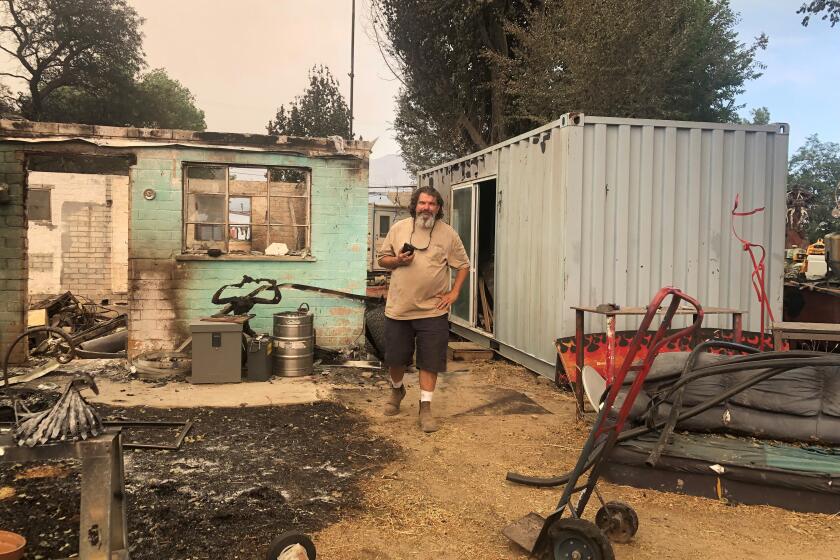California says federal ‘let it burn’ policy is reckless as wildfires rage out of control
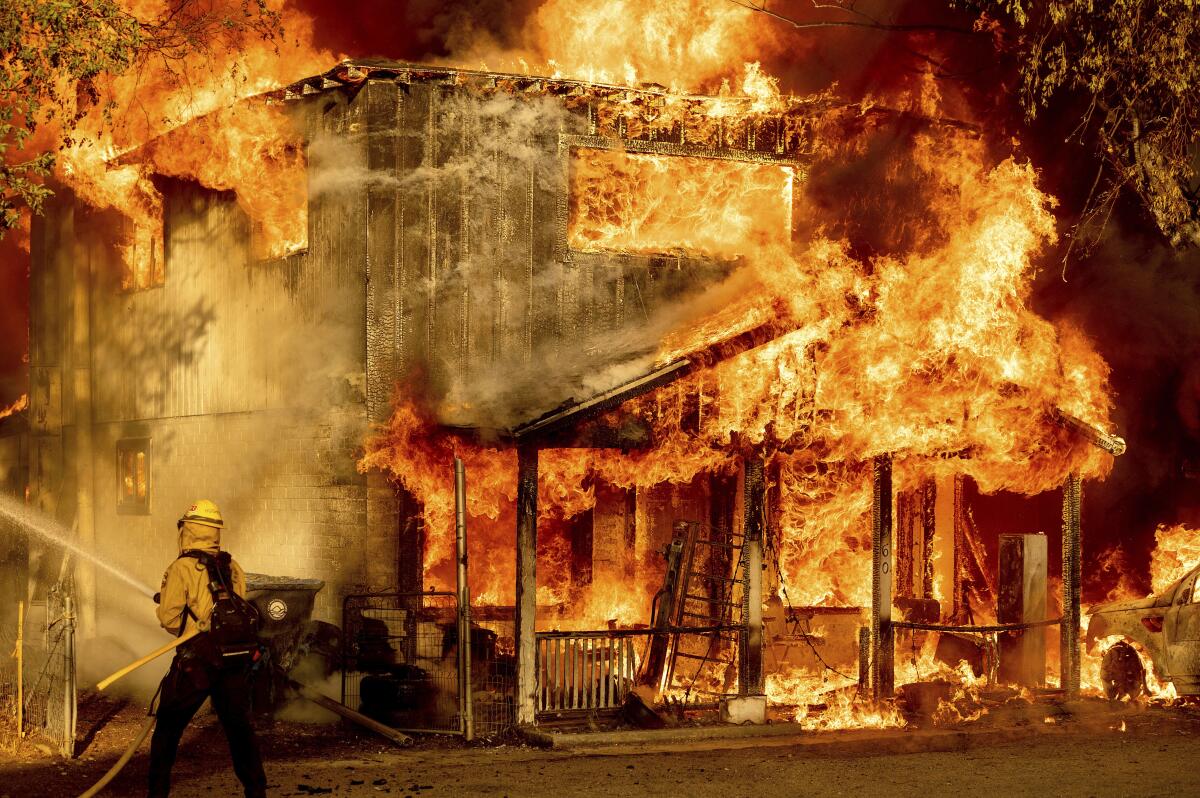
- Share via
DOYLE, Calif. — Volunteer fire chief Kathy Catron wants answers about why the Sugar fire ever grew large enough to burn her town, why it wasn’t put out before it exploded and turned uncontrollable.
“It never should have got here,” said Catron, a former school bus driver who runs a 16-person department in this Lassen County town staffed mostly by friends and family, including her kids. “It never should have happened.”
Raging July fires are becoming the norm in California. So is the animus of Catron and others about how they are fought— especially on federal lands and in their early hours — and who makes those choices. With wildfires across the West arriving earlier, spreading faster and wreaking more destruction, once-obscure policy battles between firefighting agencies are coming under public scrutiny, adding to a distrust of federal government that has long had a foothold in the rural communities most hard-hit by fire.
Who decides whether a blaze is crushed or allowed to burn is determined by jurisdiction — the federal government owns about 45% of California, more than 45 million acres, which includes the Plumas National Forest, where the Sugar fire began July 2. Federal authorities have command over fires that ignite on their property, even when they later cross off of those boundaries into populated areas.
But the U.S. Forest Service has a different philosophy on fire suppression than many state and local agencies. The California Department of Forestry and Fire Protection, which manages fires started on state and some private and local lands, aggressively works to stomp blazes out early — focused on protecting infrastructure and structures in areas that are often close to populated places.

“In my jurisdiction, I have been super aggressive in trying to put [fires] out small,” said Scott Packwood, Cal Fire’s unit chief for the Lassen-Modoc area, where the Sugar fire eventually crossed from federal to state land. “The Forest Service has different rules they work by.”
Chris Dicus, professor of fire and fuels at Cal Poly, said those different rules can lead to “significant disagreements,” though lives and the safety of firefighters are always priorities.
Largely charged with stewardship of public lands and suffering from years of inadequate funding as the cost of fighting fires has blown up, the Forest Service allows some fires to burn as part of an overall strategy to thin forests that have become dangerously overgrown. Some federal agencies view burns, planned or otherwise, as a necessity to decreasing fire risk in the future, particularly in woods that have not seen flames in generations.
In a 2018 speech, Vicki Christiansen, who stepped down as head of the Forest Service last month, called unplanned wildfires “an important land treatment tool” that required “accepting short-term risks for longer term reductions in risk.”
California leaders, though, say this mindset is outdated and minimizes the risks of fires mushrooming, especially in forests and grasslands transformed by climate change.
Already this year, there have been more than twice as many acres burned than during the same period last year — and hundreds more fires.
In a virtual meeting Friday with President Biden, Vice President Kamala Harris and governors of other Western states to discuss federal aid for fires, Gov. Gavin Newsom called the “wait and see” culture of allowing some fires to burn on federal lands the “elephant in the room.” He asked Biden for help to ensure “we’re all on the same page in terms of those initial attack strategies” to force a more aggressive federal response.
“You can’t just walk away, not with this climate, not with this drought, “ he said earlier in the week while visiting the ruin of the Tamarack fire. “This is life and death, and we can’t just fight fires the way we did 20, 30, 40 years ago anymore.”
The Tamarack has become the center of concerns about jurisdiction, accountability and policy.
U.S. Rep. Tom McClintock sent a letter to the Forest Service asking why the Tamarack wasn’t immediately suppressed, and Nevada state Rep. Jim Wheeler requested that the state attorney general investigate.
The National Wildfire Institute, a coalition that includes former Forest Service employees and industry interests such as timber companies, released a letter charging that the decision to allow it to burn “bears many hallmarks of criminal negligence” and calling for an independent investigation.
“This was a fire that burned for over a week unchecked,” said Ken Pimlott, retired director of Cal Fire, who was not involved in the letter. “Could we reasonably have expected this fire to stay at a quarter-acre for any length of time and not become a conflagration, as it did?”
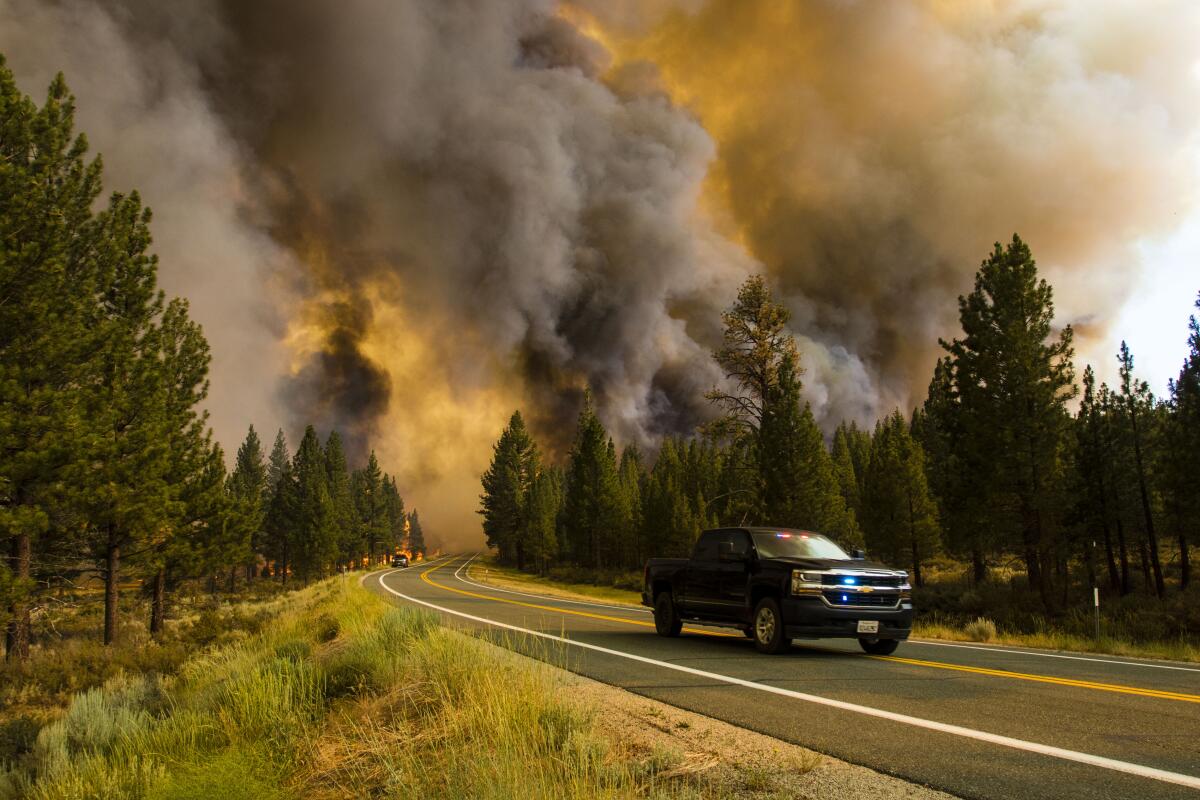
A public information officer for the command team in charge of the Tamarack fire said Saturday that she couldn’t speak to the decision to let it burn, as it took place before the team’s arrival.
“I do know that fire resources were limited and there were several higher priority fires in the area,” said Tracy LeClair. “So due to the remote location, the decision was made to monitor it.”
Andy Stahl, executive director of the watchdog group Forest Service Employees for Environmental Ethics, said despite the devastating outcomes, the problem isn’t the fires, but the growing population across once-sparsely inhabited spaces.
He contends that the fires themselves are not burning more acres than in past drought cycles, but are simply more dangerous to humans. He points out that historically, about 70% of fires extinguish naturally — just as around 2% become uncontrolled. Those numbers, he said, have remained remarkably stable despite greater fire suppression efforts.
“The 1930s, which we know from John Steinbeck as the Dust Bowl, was just as dry as today, maybe even drier, and we had horrific fires then,” Stahl said. “Entire towns were wiped out, but they had 10 people in them. Now we have Los Angeles in the way.”
Blaming the Forest Service or federal authorities for fires is like “saying the U.S. Geological Service should be more aggressive in preventing earthquakes,” he said. “With fire, we seem to have a completely different, arrogant attitude that we can control this aspect of nature, and we can’t.”
Federal firefighting authorities handling the Tamarack, which started on July 4 as a single tree hit by lightning, said they were initially confident that natural barriers would contain the flames without intervention. On July 10, the Forest Service wrote on Facebook that the fire, then about 10,000 square feet, was “surrounded by granite rocks, a small lake and sparse fuels.”
Officials said that the rugged, remote terrain presented safety concerns when it came to sending in firefighters, and that the fire posed no threat to the public. So they chose to monitor it rather than insert crews.
But 12 days after igniting, the fire took off amid gusty winds and low humidity and made a run downslope, quickly growing to 500 acres. A federal incident management team for lesser fires took over July 18, only to be replaced two days later by a new command team that specializes in the most complex fires.
As of Saturday, the fire had burned more than 68,000 acres in both California and Nevada, was 79% contained and had destroyed or damaged at least 28 structures, as more than 800 personnel worked to control it, down from 1,600 earlier.
Pimlott said that while firefighter safety is always the top priority, it can be too simple an excuse for not taking quick action. While it might have been risky then to insert firefighters, there are now hundreds of personnel assigned to the fire who are putting themselves in harm’s way, he noted.
“I spent a career as a firefighter and a forester and we do everything we can to mitigate risk for everyone,” Pimlott said. “I truly believe that taking every opportunity to keep fires small at a certain level of risk outweighs not taking any action and allowing fires to grow into conflagrations and placing hundreds of thousands of people and firefighters at risk.”
The Forest Service declined to discuss specifics beyond what has been released via social media but said that in general, such decisions are made as a team. Forest Service communications officials declined multiple interview requests, referring questions to email. Multiple questions on policy referred to the national offices of the Forest Service were not answered.
“Wildfire decisions are inherently complex,” spokeswoman Susanne Tracy wrote in an email about the Tamarack fire. “These decisions are based on sound risk management and the best information available, including: fire behavior, fire danger conditions, hazards and mitigation, available resources, firefighter and public safety, values that might be threatened, and benefits that could be obtained.”
The Sugar fire, which later merged with the nearby Dotta fire to become the Beckwourth Complex, shares a similar origin story.
Started by a July 2 lightning strike deep inside the nearby Plumas National Forest, it burned on federal lands for days, eating through a dense underbelly of fallen needles, dead logs and other brush that reached four feet high in some places, said Catron, the fire chief.
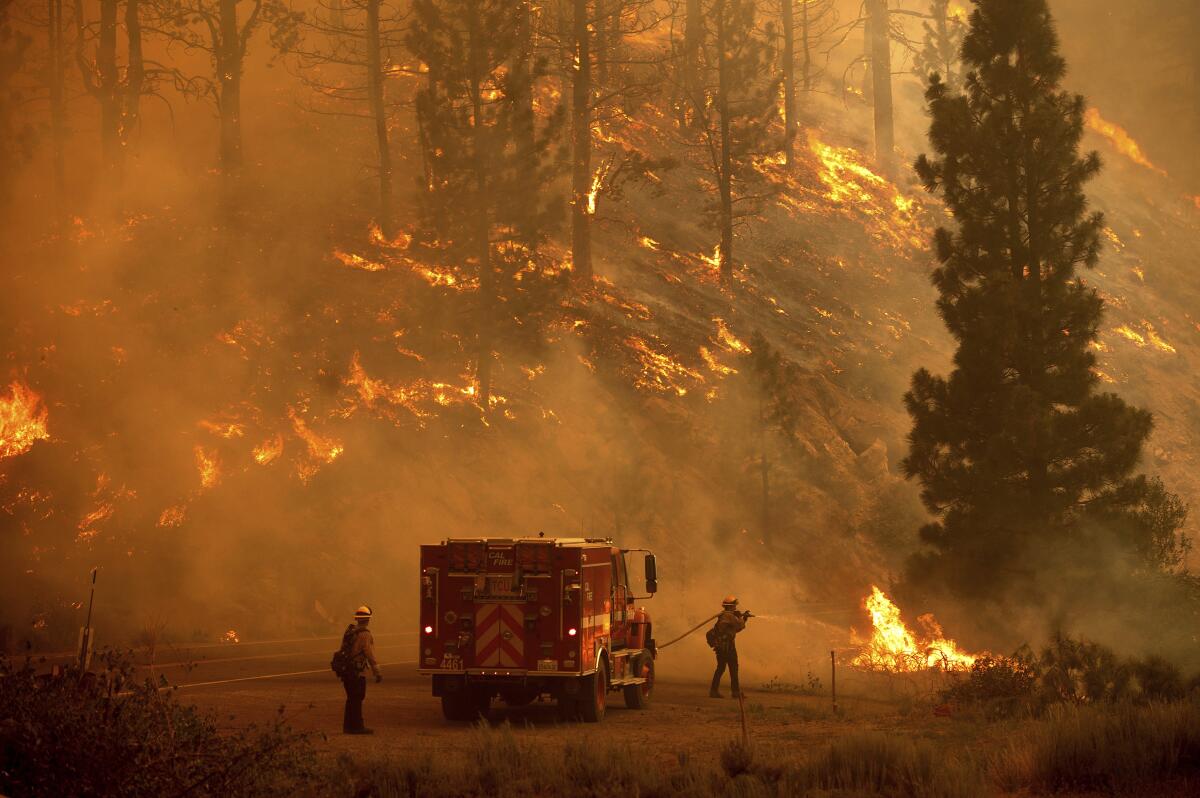
Then the weather changed and firefighters lost control. By July 10, flames had traveled miles, cresting the mountains that divide Doyle from the forest, sweeping down the dry hillside into its ranches before jumping the freeway and burning a row of historic buildings. In all, 33 homes were lost in a town of 700 people, said Catron. As of Friday, it had burned more than 105,000 acres and was 98% contained.
Dicus, the professor, said much of the tension between fighting or monitoring fires comes down to resources.
In 2020, Congress allocated more than $6 billion for wildfires across agencies, with more than half of that tagged for fire suppression, and the Biden administration has plans for expanding hiring and increased pay for federal firefighters.
But so far in 2021, there have been 5,600 fire starts in California, a record for this time of year. More than 480,000 acres have already burned, another dismal record. Speaking to Biden, Newsom said 59 fire starts were put out Thursday alone.
With tinderbox conditions across the West, federal fire crews are stretched thin, making it impossible to put out every spark even with the vast web of mutual aid agreements that include local, state and even international partners. More than 80 large fires have already burned 1.7 million acres across 13 states this year, with 21,500 firefighters and 28 incident command teams battling them, according to the National Interagency Fire Center.
Dealing with scarcity, federal command teams must make decisions daily on where to fight and where to watch — including on lands where forests have grown dense and vulnerable to large blazes because of past successful suppression efforts.
But partly because of lack of congressional investment, federal authorities are behind on better managing forests. The Department of the Interior and the Forest Service identified nearly 120 million acres of federal lands at substantial risk of wildfire. Between 2009 and 2018, those agencies performed fuel reduction on only about 2.5 million acres annually, though — hampered as fire suppression has steadily consumed greater chunks of budgets. An agreement signed last year between California and the federal government to do more maintenance work remains unfunded on the federal side, Newsom said last week.
“We shouldn’t have to prioritize,” said Nevada Gov. Steve Sisolak, speaking as he toured destruction from the Tamarack fire with Newsom. “We should have enough resources where we can attack all these simultaneously.”
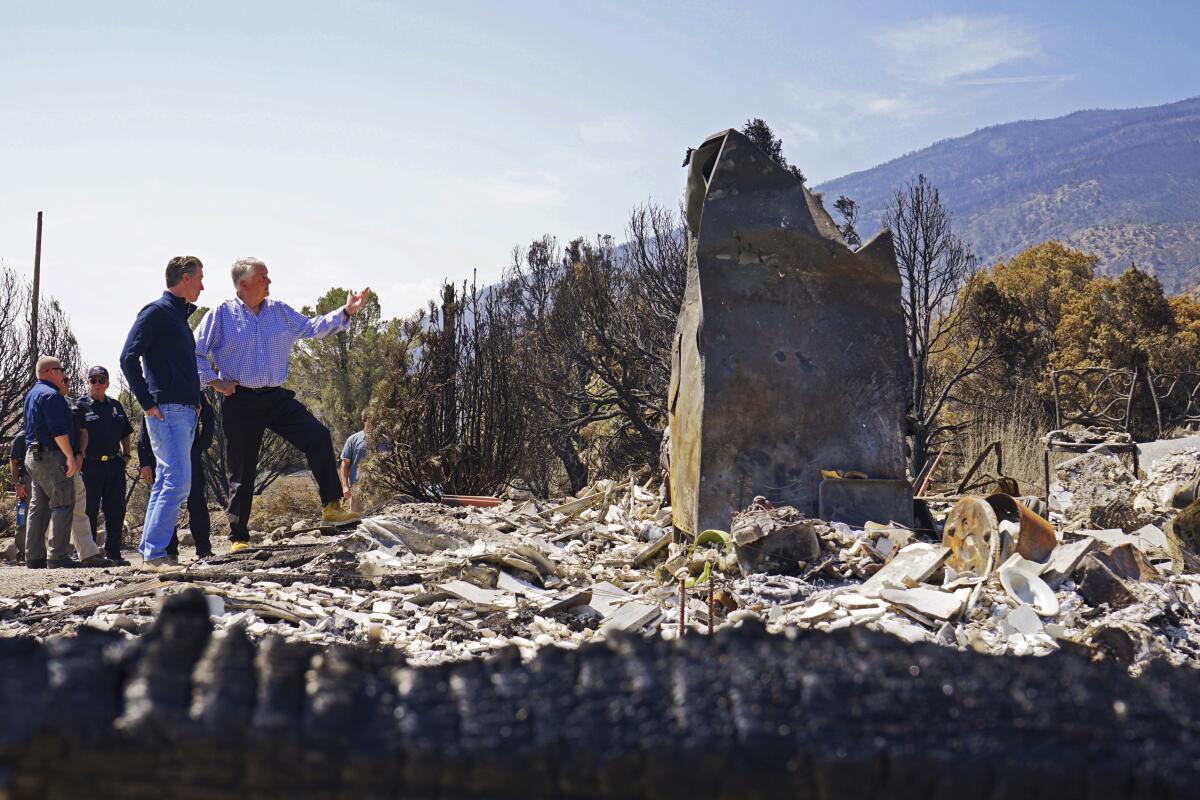
Without a greater focus on fuels reduction, firefighting decisions are sure to become more contentious.
As it is, local communities are often left seeking answers after the smoke clears, and incident command teams depart and move on to other fires. Lassen County Administration Officer Richard Egan said it is difficult to get satisfying explanations from the federal government.
“They are masters at, I think the correct term is, gaslighting,” Egan told U.S. Rep. Doug LaMalfa at a meeting days after the Sugar fire hit Doyle. “They are terrible neighbors for us.”
As the hot ash of demolished homes in Doyle still smoldered nearby, Catron, the fire chief, smoked a Marlboro pulled from a wallet decorated with a wolf and a dreamcatcher. She was with her daughter Haley, 19, one of the youngest members of the volunteer fire department, when the Sugar fire crested the peaks above town.
Some of the ranchers on the road at the base of the hill had decided not to evacuate, and Catron was bringing milk to an elderly couple.
Haley remembers a sound like a freight train. Her mom thought she heard a screaming cow, maybe in pain. Then fire was heading straight toward them, multiple tornadoes whirling in its midst. Haley couldn’t stop staring, mesmerized by the kinetic vastness, remembering now that she just “wanted it to be over,” she said.
Catron said she had been warned the fire was approaching, but when it finally broke over the mountain, she received no communication from federal authorities, a claim backed by Lassen County Sheriff’s Capt. Mike Carney, who was out checking on evacuations.
“I wouldn’t even say the communication was poor,” Carney said later. “I would say it was nonexistent.”
High rents drove Mike Snook out of his arts-collective warehouse in Oakland. He relocated to Doyle, where a wind-swept wildfire wrought devastation.
Catron said there weren’t enough engines to protect the homes in the line of fire. The ones up the hill were forced to retreat as flames shot down the canyon-like road, flying across the highway into the yard of a Bureau of Land Management fire station, where sparks quickly took hold. Within minutes, embers reached homes that no one had expected to be in danger. She responded, but knew in a town that relies on water from wells — which went dead when the power shut off — her engines were no match for the whims of the Sugar.
It didn’t stop her from trying.
Her great-great-grandfather founded this town, its first postmaster. Her grandmother raised eight kids in a two-bedroom house here. Now her grandkids are growing up under its endless desert sky, catching and racing blue-bellied lizards in the park during an annual competition called Doyle Days. Her sister lives on the mountain road where the fire tore down, her aunt’s house was in the line of ranches where she was delivering groceries. She can’t drive a block without a car stopping, asking through the window for the latest news.
The lack of answers feels like indifference to everything she loves.
“I am not placing any blame on anyone in particular, but something went wrong,” she said, drawing on another cigarette. “This could have taken everything from everybody.”
More to Read
Sign up for Essential California
The most important California stories and recommendations in your inbox every morning.
You may occasionally receive promotional content from the Los Angeles Times.

